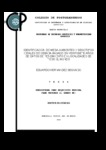Identificación de mega-ambientes y genotipos ideales de cebada basado en veintisiete años de datos de rendimiento en localidades de todo el mundo
Abstract
La presente investigación fue basada en información recabada durante veintisiete años de mejoramiento por el programa de cebada ICARDA-CIMMYT; derivada de la siembra del ensayo internacional IBYT (International Barley Yield Trial) en 77 países, 251 localidades, 750 experimentos y 750 genotipos. Este estudio tuvo como principales propósitos observar la diversidad genética de la cebada para adaptarse a una gran gama de ambientes contrastantes, identificar los mega-ambientes en el mundo para el cultivo de la cebada (Hordeum Vulgare L.), identificar las mejores localidades en todo el mundo para hacer mejoramiento genético de la cebada, así como identificar por su gran estabilidad y rendimiento, a los mejores genotipos a través de años y localidades, al mismo tiempo este estudio permitió contabilizar el avance genético de líneas liberadas al mundo, en términos del incremento en rendimiento y resistencia a enfermedades a través de los años. Los resultados indicaron que el cultivo de la cebada tiene una amplia adaptabilidad a una gran variedad de ambientes, destacando aquellos donde las condiciones ambientales no son aptas para otros cultivos y ofreciendo por ende una alternativa viable para agricultores pobres del planeta. Este estudio permitió identificar tres grandes mega-ambientes diferenciados en gran parte por su temperatura y precipitación, al mismo tiempo se identificó una localidad clave ó representativa de cada mega-ambiente; las tres localidades que mejor representan a los tres mega-ambientes son: Leída, España; Boulifa, Túnez y Setif, Argelia. Estas tres localidades se encuentran entre los 36 y 41 grados de latitud norte y las tres comparten un clima tipo mediterráneo en común. Se identificaron veintisiete genotipos; uno por cada año de estudio, los cuales mostraron los mejores rendimientos y estabilidad a través de localidades, cada uno de estos genotipos se propone para cada mega-ambiente identificado._________This research was based on information gathered during twenty-seven years of breeding by the ICARDA-CIMMYT barley program, derived from the planting of the international barley yield trial (IBYT) in 77 countries, 251 locations, 750 experiments and 750 genotypes. This study had as main purpose to observe the genetic diversity of barley adaptation to a wide range of contrasting environments, identify the mega-environments in the world for growing barley (Hordeum vulgare L.), to identify the best locations throughout the world for genetic improvement of barley, as identified by their high stability and performance improved genotypes through the years and locations, while this analysis allowed us to visualize the progress of released lines for yield and diseases resistant through years. The results indicated that the barley crop has a wide adaptability to a variety of environments, highlighting those where environmental conditions are not suitable for other crops and thus offering a viable alternative, especially in marginalized areas for the poor producers of the world. This study allowed to identify three main mega-environments differentiated largely by precipitation and temperature at the same time identify a representative location of each key or mega-environment, the three areas that best represent the three mega-environments are Leida, Spain, Boulifa; Tunisia and Setif, Argelia. These three sites are between 36 and 41 degrees north latitude and all three have in common a Mediterranean climate. Twenty-seven genotypes were identified, one for each year of study, which showed the best performance and stability through villages, each of these genotypes is proposed for each identified mega-environment.
Collections
- Tesis MC, MT, MP y DC [186]

